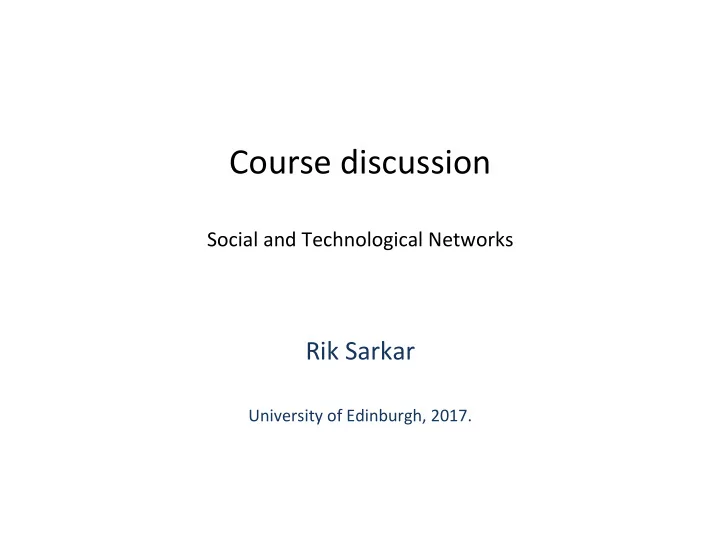

Course discussion Social and Technological Networks Rik Sarkar University of Edinburgh, 2017.
Today • Course and Project: follow up discussion • Lectures • What to study for exam • What to expect in exam
Projects • The intenKon: • Learn to iniKate and do own projects • Imagine and try creaKve ideas – Failure is fine. • Build the idea into something workable – Through trials and errors • What did you think?
Projects • The intenKon: • Learn to iniKate and do own projects • Find creaKve ideas • Try to do the project, and realise there are roadblocks, or the idea does not work as intended • Find more ideas to overcome problems, and repeat – Redo part of the project – SomeKmes large parts, someKmes the enKre thing.. • Plan Kme and work accordingly. Then re-plan, and repeat..
Projects • How work happens in real world – everything is a project! • Usually you are not given complete instrucKons – Finding out what to do is part of the job – Works beUer if you do something original instead of the obvious
Projects and original efforts • Companies prefer someone who takes iniKaKve to do something new instead of just follow instrucKons • More people are working on startups, own business, consultancy etc. – It is useful to always think about what you can do different
• If you enjoyed trying your ideas, consider doing a PhD – Opportunity and Kme to learn cuZng edge stuff – Try your own ideas – Develop longer term plans etc • Many companies (Google, MS) prefer PhD • A good place to start startups or your own things • ApplicaKons usually in december/january • See my web page for the applicaKon process at Edinburgh (apply to other places too!)
• But do consider pracKcal issues too • And more importantly what you prefer • If you are unsure or have quesKons, talk to someone!
Your Feedback • Mixed response to 20pt course. • Several of you would have liked tutorials – Will take this into account – (Time is the constraining factor) • Mixed response to mathemaKcal models vs computaKonal algorithms and data mining. • More real applicaKons
• One more exercise set to be uploaded later this week • Kleinberg and Easley 2010 has quesKons acer each chapter.
Lectures • The intenKon • Give you an overview of topics in Network Science • Some idea of the types of analysis and techniques used in the field • How intuiKve ideas can be made rigorous and analysed • To give you enough idea so that now if faced with a networks problem, you know where to look or what may be relevant
Lectures • PracKcal issues • The area is large • Some techniques are quite involved and we did not have a lot of Kme • Advanced material are not good for exams • We needed some relaKvely simple material for exams • The balance between depth and breadth is difficult
Slides and reading • Please use the latest online version (these may get slight updates/correcKons) • Let me know any errors/omissions you noKce • Exam material : slides and reading lists (not addiKonal reading) • One more exercise set will be uploaded
Exam • What to expect: • Similar to last year’s exam, but possibly slightly more mathemaKcal – Less involved than exercises • You are not expected to reproduce enKre proofs from class – But expected to understand them – To answer quesKons about them – Or use some similar techniques in answering different quesKons
VisiKng students • Exam in december • Things uploaded acer today not in exam • Expect exam similar to last year.
Some typical quesKons: • Define property/measure X. – For a given graph in Figure, compute X – eg. CC/betweenness of each node, of the graph, diameter of the graph, matrix A or L etc.. • For a descripKon of a graph, show that it must have the following property …. – Examples in exercises
• Given a problem such as … – How would you solve this? What algorithm will you use? JusKfy your answer. – How would you construct a network? • What are the advantages/disadvantages of using X in problem setup Y?
Recommend
More recommend